Best to Worst: Countries That Serve as Stand-Ins for the American West
You don't have to go to the West to make a western (or any other movie set in the American West). Sometimes it's even better if you don't.
Best to Worst is an ongoing series of narrowly focused, from-the-gut rankings of various film and film-adjacent subjects.
The American West is a place on the map but it’s also an idea, a stretch of psychic geography that the movies can capture without even traveling there. You don’t have to go to the West to make a western, in other words, or other stories set on the American frontier (or the frontier that used to be). If you’re a filmmaker with a limited budget, shooting in the actual Monument Valley might be prohibitively expensive. It might also not be the best artistic choice. The way actual local flavor soaks into films set in the West can make them feel distinctive, and sometimes distinctiveness is better than authenticity. Sergio Leone shot part of his masterpiece Once Upon a Time in the West in America, for instance, but despite recognizable landmarks it still seems to take place in the only-in-movies version of the West Leone helped create in Spain.
The Reveal is a reader-supported newsletter dedicated to bringing you great essays, reviews and conversation about movies (and a little TV). While both free and paid subscriptions are available, please consider a paid subscription to support our long-term sustainability.
What follows is a ranking of alternate movie Wests, and though it’s arranged from best to worst there’s really no bad foreign Western locations. (Well, maybe one.) Even the lower ranked countries’ visions of American myth have their unique charms. It’s just that some have a history of working better as on-screen stand-ins than others. Sometimes you can get swept up in a film and buy into whatever reality it creates. Sometimes you're left wondering, “What part of Arizona is that supposed to be?”
Left unranked: The United States (for obvious reasons) and Mexico, since its own landscape has been just as much a part of the movie West as territory north of the Rio Grande.
1. Spain
Sergio Leone didn’t singlehandedly create the spaghetti western with 1964’s A Fistful of Dollars. Others made westerns in Europe before Leone (as evidenced below). They’d even shot them in the southern Spanish province of Almeria. But the combination of Leone’s choice of location and his distinctive style — a mix of extreme close-ups, sweeping landscapes, shocking flashes of violence, dark humor, and mythic self-awareness — set the standard the explosion of European-produced westerns that followed would try to match. In the lonely, arid deserts of Almeria he created a heightened version of the American West, one that reduced it to its basic elements, freeing Leone, and those that followed, to fill in the empty spaces as they liked.
2. Canada
It’s almost not fair to include Canada on this list since a) a fair number of westerns (and their Canadian counterpart, northerns) have been set in Canada, and b) the southern stretches of the Canadian West look an awful lot like the northern stretches of the western United States. It’s just not that much of a stretch. Still, credit where it’s due: Canada does an excellent job subbing in for the States in everything from McCabe and Mrs. Miller to Unforgiven to Brokeback Mountain to The Revenant (partly; see below). As alternate Wests go, however, it’s a sturdy, reliable choice. Nicely done, Canada!
3. New Zealand
Let’s call New Zealand number three with a bullet. The country’s South Island subbed so convincingly in for Colorado in John Maclean’s very good 2015 western Slow West that it seemed to set off a lightbulb for other filmmakers. Since then we’ve seen Kiwi-enhanced versions of the West in Pete’s Dragon, the Netflix series Sweet Tooth, Jane Campion’s The Power of the Dog and elsewhere. Like Spain, New Zealand works not so much because it looks like the American West but like an alternate movie universe version. Its forests look a little too verdant, its plains a little too barren, and its mountains just a little off, but for some reason its not-quite-America-but-almost-America version of the West works by removing realism from the equation.
4. Italy
While many Italian filmmakers hurried to Spain to recreate the American West, some found a suitable substitute within their own borders. The country’s southern regions can fill in for the deserts of the American Southwest while the mountainous north can double for other regions. For a great example of the latter, look no further than Sergio Corbucci’s brutal 1968 film The Great Silence, which makes those beautiful, snow-capped crags look as unforgiving as the lonely desert stretches. Also worth noting: many memorable Western scenes were shot at Rome’s Cinecittà studio, just not the sort that showcase the landscape.
5. Israel
The blasted sandscape of Israel’s Negev Desert doesn’t look much like the American West. Nor does what sparse vegetation grows there. But if realism isn’t your primary concern then Israel can make a fine stand-in, as in Roland Klick’s 1970 film Deadlock, an intense psychological thriller set in a “California” every bit as heightened and unconventional as the score by krautrock giants Can (or “The Can,” as the credits would have it).

6. Croatia
Before Sergio Leone and the Italian film industry carved out a bit of the Old West in Spain German filmmakers did the same in Croatia (then part of Yugoslavia). If you’ve never heard of Winnetou, Old Shatterhand, or their creator, Karl May, chances are you’re not from Germany, where May’s Old West adventures, first published at the end of the 19th century, were once wildly popular (and still maintain a enough of a following to sustain an annual festival). Starting with The Treasure of Silver Lake in 1962, American actor Lex Barker revived his flagging career playing the western hero Old Shatterhand opposite French actor Pierre Brice as his Apache blood brother Winnetou in eleven films that played to great success in Europe. They were largely shot in wilderness regions of Croatia that, while lovely, never quite feel like the American West, which is kind of appropriate given that May’s understanding of the region seems a little shaky.
7. Bulgaria
Bulgaria has proven itself to be an effective-enough substitute for many different locations, from the Ancient Greece of 300 to Robert E. Howard’s Cimmeria in Conan the Barbarian. But the most recent attempt to summon the spirit of the American West there, Netflix’s Texas Chainsaw Massacre, never passes the smell test. It looks flat and arid but not the right kind of flat and arid, and never flat and arid in ways that enhance the film. Also the movie is pretty bad. It might take a while for Bulgaria to recover from this one.
Incomplete: Argentina
Argentina’s an alternate American West just waiting for its breakout moment. Gus Van Sant filmed part of his lost-in-the-desert movie Gerry there before inclement weather made him return to the U.S. By contrast, a snow shortage in Canada drove Alejandro González Iñárritu to film the finale of The Revenant there. In both cases, Argentina doesn’t quite look like the American West but it does look like a rich, heightened approximation of the American West. Could Argentina, not New Zealand, be the 21st century’s Almeria? Will the green screen fakery that’s taken over other genres become the norm? Could, say, Estonia be the next hot destination for cowboys and other Western denizens? Stay tuned!











"Sometimes it's even better if you don't." Bingo. Sam Elliott is owed the right to an opinion on the fidelity of movie settings, but there is certainly a worthy discussion to be had about the value of intentionally introducing dissonance through settings and shooting locations. Campion's New Zealand stand-in gives her movie an other-worldly quality that amps up the tension and the internal and external isolation of the characters. It works BECAUSE it is shot where it was shot.
I also think of Lars von Trier, who has made a series of fantastic movies about America that were not set in America. Heck, von Trier is on record as having never been to the United States. Something about that remove makes the cultural critiques and tone of his films more potent.
I think the United States could have its own rankings based on how convincingly the location used represents the location allegedly depicted. The Searchers is a great movie, but when the opening title says TEXAS 1868, then immediately shows us Monument Valley, there's a bit of disconnect. Similarly, any movie that claims to be taking place in Montana or Utah but winds up shooting in Bronson Cavern is immediately disappointing, mostly because Bronson Cavern should be used strictly as a hiding place for monsters in Roger Corman pictures.